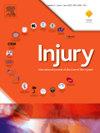急诊住院时间延长与静脉血栓栓塞预防和创伤预后的关系:一项全国性的二级分析。
IF 2.2
3区 医学
Q3 CRITICAL CARE MEDICINE
Injury-International Journal of the Care of the Injured
Pub Date : 2025-05-01
DOI:10.1016/j.injury.2024.112079
引用次数: 0
摘要
在创伤患者中,急诊住院时间延长(EDLOS)对适当时间的药理学静脉血栓栓塞预防(VTEp)和VTE结局的影响尚不清楚。方法:对参与美国外科医师学会TQIP(2019-2021)的民用创伤中心收治的成年患者进行回顾性队列研究。排除严重实体器官、头部或脊柱损伤、早期出血控制干预、已有家庭抗凝或出血障碍、机构间转院或提前出院、损伤严重程度评分≤9的患者。主要暴露为从急诊科到达到物理转移到病房的EDLOS延长≥12小时。结果:共纳入191,031例患者,其中3827例患者处于≥12小时的ED状态,达到VTEp的中位时间为25小时(IQR 12-43)。延长的EDLOS分别与24小时(aHR 0.66, 95% CI 0.61-0.72, P < 0.001)和48小时(aHR 0.79, 95% CI 0.74-0.84, P < 0.001)及时给药VTEp降低34%和21%相关。倾向评分匹配后,相关性持续在24小时(aHR 0.69, 95% CI 0.61-0.77, P < 0.001)和48小时(aHR 0.80, 95% CI 0.74-0.86, P < 0.001)。VTEp缺失24 h与VTE几率增加相关(aOR 1.84, 95% CI 1.62 ~ 2.08, P < 0.001)。结论:在全国范围的创伤患者队列中,延长的EDLOS延迟了药理学VTEp。因此,没有VTEp会增加院内VTE的风险,尽管需要进一步的研究来验证这些发现。及时将稳定的创伤患者转移到地板可以通过促进适当的VTEp给药和减少ED过度拥挤来改善结果。本文章由计算机程序翻译,如有差异,请以英文原文为准。
Association of prolonged emergency department length of stay and venous thrombo-embolism prophylaxis and outcomes in trauma: A nation-wide secondary analysis
Introduction
The impact of prolonged emergency department length of stay (EDLOS) on appropriately timed pharmacological venous thromboembolism prophylaxis (VTEp) and VTE outcomes is unknown in trauma.
Methods
Retrospective cohort study of adult patients admitted to civilian trauma centers participating in the American College of Surgeons’ TQIP (2019–2021). Patients with severe solid organ, head, or spine injury, early hemorrhage control intervention, pre-existing home anticoagulation or bleeding disorder, inter-facility transfer or early discharge, and injury severity score ≤9 were excluded. Primary exposure was prolonged EDLOS ≥12 h from ED arrival to physical transfer to the wards. Primary outcome was time to first pharmacological VTEp, censored at 24 and 48 h.
Results
A total of 191,031 patients were included, 3,827 remained in the ED ≥12 h. The median time to VTEp was 25 h (IQR 12–43). Prolonged EDLOS was associated with a 34 % and 21 % decrease in timely administration of VTEp at 24 (aHR 0.66, 95 % CI 0.61–0.72, P < 0.001) and 48 h (aHR 0.79, 95 % CI 0.74–0.84, P < 0.001), respectively. After propensity score matching, associations persisted at 24 (aHR 0.69, 95 % CI 0.61–0.77, P < 0.001) and 48 h (aHR 0.80, 95 % CI 0.74–0.86, P < 0.001). Absent VTEp by 24 h was associated with increased VTE odds (aOR 1.84, 95 % CI 1.62–2.08, P < 0.001).
Conclusion
Prolonged EDLOS delayed pharmacological VTEp in a nation-wide cohort of trauma patients. Absent VTEp, consequently, increased risk of in-hospital VTE, although future study is needed to validate these findings. Timely transfer of stable trauma patients to the floor may improve outcomes by facilitating appropriately timed VTEp administration and decreasing ED overcrowding.
求助全文
通过发布文献求助,成功后即可免费获取论文全文。
去求助
来源期刊
CiteScore
4.00
自引率
8.00%
发文量
699
审稿时长
96 days
期刊介绍:
Injury was founded in 1969 and is an international journal dealing with all aspects of trauma care and accident surgery. Our primary aim is to facilitate the exchange of ideas, techniques and information among all members of the trauma team.

 求助内容:
求助内容: 应助结果提醒方式:
应助结果提醒方式:


